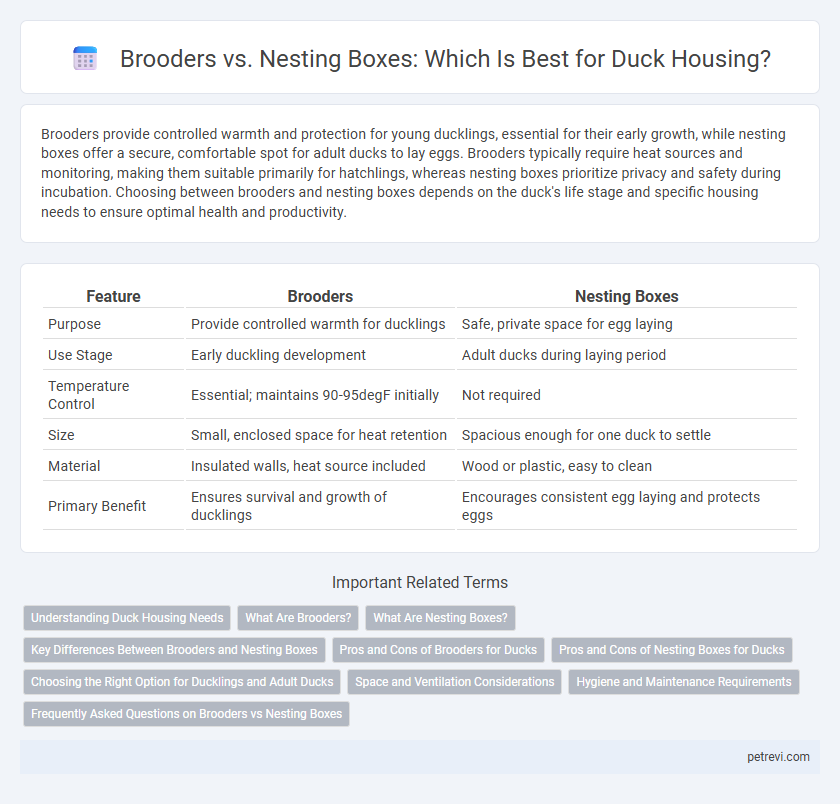Brooders provide controlled warmth and protection for young ducklings, essential for their early growth, while nesting boxes offer a secure, comfortable spot for adult ducks to lay eggs. Brooders typically require heat sources and monitoring, making them suitable primarily for hatchlings, whereas nesting boxes prioritize privacy and safety during incubation. Choosing between brooders and nesting boxes depends on the duck's life stage and specific housing needs to ensure optimal health and productivity.
Table of Comparison
| Feature | Brooders | Nesting Boxes |
|---|---|---|
| Purpose | Provide controlled warmth for ducklings | Safe, private space for egg laying |
| Use Stage | Early duckling development | Adult ducks during laying period |
| Temperature Control | Essential; maintains 90-95degF initially | Not required |
| Size | Small, enclosed space for heat retention | Spacious enough for one duck to settle |
| Material | Insulated walls, heat source included | Wood or plastic, easy to clean |
| Primary Benefit | Ensures survival and growth of ducklings | Encourages consistent egg laying and protects eggs |
Understanding Duck Housing Needs
Brooders provide controlled warmth essential for ducklings' early development, while nesting boxes offer a secure and comfortable space for adult ducks to lay eggs. Proper duck housing ensures appropriate temperature, ventilation, and protection from predators, essential for health and productivity. Tailoring housing solutions to specific life stages improves growth rates, egg production, and overall welfare.
What Are Brooders?
Brooders are heated enclosures designed to provide young ducklings with a warm, controlled environment essential for their early development and survival. These units maintain consistent temperatures, typically between 85-95degF (29-35degC), mimicking the mother's natural body heat, which is crucial during the first few weeks after hatching. Unlike nesting boxes, brooders focus on temperature regulation and protection from drafts, fostering growth and reducing mortality in ducklings.
What Are Nesting Boxes?
Nesting boxes are enclosed compartments designed to provide ducks with a safe, comfortable area for laying eggs and protecting their clutch from predators. They are typically filled with soft bedding materials like straw or wood shavings to mimic natural nesting conditions and encourage consistent egg-laying behavior. Unlike brooders, which regulate temperature for ducklings, nesting boxes primarily focus on offering privacy and security for adult ducks during the nesting period.
Key Differences Between Brooders and Nesting Boxes
Brooders provide controlled warmth and protection for ducklings during their early development, using heat sources like heat lamps or heated pads to maintain optimal temperatures. Nesting boxes serve as designated laying areas for adult ducks, designed for egg collection and comfort without temperature regulation. The primary difference lies in brooders supporting early growth needs with heat, while nesting boxes focus on facilitating safe and productive egg-laying environments.
Pros and Cons of Brooders for Ducks
Brooders provide a controlled, warm environment essential for ducklings during their first few weeks, promoting rapid growth and reducing mortality rates. They allow for easy temperature regulation and protection from predators or harsh weather, but require constant monitoring to avoid overheating or insufficient warmth. However, brooders can be costly to maintain and may limit natural behaviors compared to more spacious nesting boxes.
Pros and Cons of Nesting Boxes for Ducks
Nesting boxes for ducks provide a secure and comfortable space for egg-laying, helping to protect eggs from predators and environmental hazards. They encourage natural nesting behavior, which can improve egg production and reduce stress in ducks. However, nesting boxes require regular cleaning to prevent disease, and improper design or placement may lead to overcrowding or discourage ducks from using them effectively.
Choosing the Right Option for Ducklings and Adult Ducks
Brooders provide controlled warmth and protection essential for ducklings during their first weeks, mimicking natural heat from a mother duck, while nesting boxes offer a secure, comfortable space for adult ducks to lay eggs and rest. For ducklings, a brooder with adjustable heat and proper ventilation optimizes growth and survival rates, whereas nesting boxes designed with adequate size and padding enhance adult duck comfort and egg safety. Selecting the right housing depends on the duck's life stage, with brooders ideal for early development and nesting boxes for mature ducks' reproductive needs.
Space and Ventilation Considerations
Brooders provide controlled warmth and ventilation, making them ideal for ducklings requiring consistent temperature and airflow, while nesting boxes prioritize space efficiency for adult ducks during laying. Proper ventilation in brooders prevents respiratory issues by reducing humidity and ammonia buildup, whereas nesting boxes must ensure enough room to avoid overcrowding, which can lead to stress and decreased egg production. Combining adequate space with effective airflow is essential in both housing options to maintain duck health and productivity.
Hygiene and Maintenance Requirements
Brooders require regular cleaning and disinfection due to high moisture levels from heat lamps and water spillage, which can promote bacterial growth and odors. Nesting boxes offer better hygiene by providing a dry, enclosed space that limits exposure to droppings and reduces contamination risks. Maintenance of nesting boxes is generally simpler, involving routine replacement of bedding material, while brooders demand more intensive daily upkeep to ensure a healthy environment for ducklings.
Frequently Asked Questions on Brooders vs Nesting Boxes
Brooders provide controlled warmth essential for ducklings' early development, while nesting boxes offer a safe, comfortable space for adult ducks to lay eggs. Frequently asked questions often address temperature regulation in brooders and the ideal size and placement of nesting boxes to ensure optimal duck health and egg production. Proper use of both enhances duck housing efficiency and supports different life stages.
Brooders vs Nesting Boxes for Duck Housing Infographic

 petrevi.com
petrevi.com